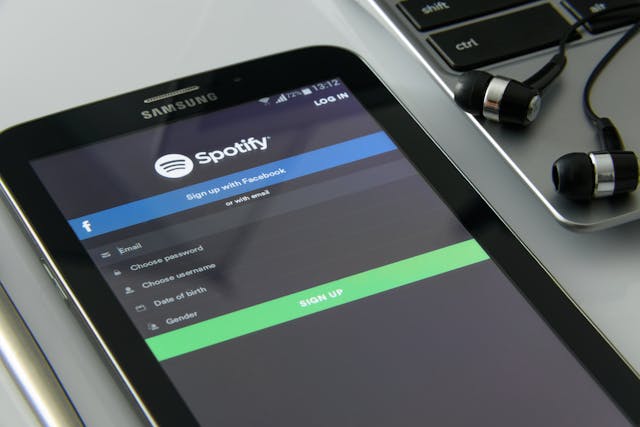Estimating future streams on Spotify is essential for artists aiming to grow their music’s reach. By predicting potential streams, artists can make better decisions about promotions and release timing. Understanding trends, analyzing metrics, and leveraging tools can all play a big role in making accurate predictions.
From looking at current streaming numbers to using tools like stream calculators, there are various ways to forecast performance. Accurate estimates can help artists strategize and set realistic goals for growth. This guide will walk you through how to estimate future streams on Spotify, helping you maximize your music’s impact.

Analyzing Your Current Streams To Predict Future Growth
Spotify and SoundCloud are great platforms for artists to publish their music. Analyzing your current streams is a smart way to predict future growth on Spotify. Here are some ways to do that:
- Start by examining key streaming metrics, like the number of streams, skips, and saves. Each of these numbers offers insights into how listeners respond to your music. High save rates, for example, often indicate that listeners are interested in revisiting your tracks.
- Looking at listener behavior, such as the average listen duration, can also be helpful. If listeners often play your tracks in full, your music likely resonates with them.
- Similarly, examining geographic data helps you understand where your audience is located. Knowing your audience’s location is useful for targeting specific regions with ads or promotions.
- Another metric to track is playlist placements. If your track is frequently added to playlists, it suggests a strong potential for growth. Playlist placements often drive new listeners, boosting your song’s reach and streams.
- Additionally, analyzing the types of playlists can reveal what themes or genres attract your listeners.
- Monitor repeat listens to gauge your music’s long-term appeal. Repeat listening indicates deeper engagement, which can lead to steady or increasing streams over time.
By closely tracking these metrics, you gain valuable insights into Spotify’s future growth potential.

How To Estimate Spotify Streams Based Upon First-Day Numbers
Wondering how to estimate streams on Spotify based on your first-day numbers?
Estimating Spotify streams based on first-day numbers can give valuable insights into future performance. Your track’s initial day can indicate how listeners will respond over time. High stream counts on release day suggest strong initial interest, which can mean sustained engagement.
To estimate growth, start by looking at the total number of streams collected on the first day. Compare this to your past releases to spot any patterns in listener engagement. A track that performs better than previous releases may continue trending upward.
Also, check for playlist additions on the first day, as this boosts visibility and potential future streams.
Another helpful metric is the number of times listeners saved or shared your track. High save and share counts often indicate genuine interest. If listeners are quick to save your song, they may return to it, leading to more streams. High shares also show that listeners are eager to spread your music to others.
Pay attention to early engagement from your social media promotion. Strong first-day support from fans or influencers can push the track to a wider audience.
Analyzing these first-day metrics will give you a solid foundation for estimating future individual stream counts on Spotify.

Using a Spotify Stream Calculator for Forecasting
A Spotify Stream Calculator is a useful tool for forecasting your track’s future streams. This tool estimates potential streams based on current data, helping artists set realistic goals. By inputting numbers like current streams, follower count, and engagement rate, you get an immediate projection.
Using a stream calculator is straightforward.
First, gather key metrics from your Spotify account. These can include daily stream averages, saves, and playlist placements. Many calculators allow you to enter these metrics to forecast future growth. While these tools aren’t perfect, they can give a solid baseline for what to expect.
One advantage of using a Spotify Stream Calculator is its speed. You can get an instant prediction without deep data analysis. This can be helpful when planning promotions or release strategies. For instance, if the calculator shows high potential growth, you might invest more in ads or influencer marketing. These are also some great strategies to consider when you are thinking about social media marketing for other platforms.
However, it’s essential to remember that calculators provide estimates, not guarantees. Many factors, like changes in the algorithmic recommendations or trends, can impact actual streams. To improve accuracy, use the calculator along with your regular analysis.
Combined, these tools offer a balanced approach to forecasting your music’s future performance on Spotify.

The Spotify Streams Predictor: How It Works and What It Offers
The Spotify Streams Predictor is a valuable tool that helps artists anticipate streaming numbers more accurately. By analyzing key metrics, the predictor provides estimates for future streams based on current performance. This tool can assist artists in understanding growth potential and planning release strategies.
A Spotify Streams Predictor analyzes your track’s engagement, such as saves, shares, and plays. It also considers your listener demographics and playlist placements. By compiling these metrics, the predictor generates a projection that highlights your track’s streaming potential over time.
Using a streams predictor can give you deeper insights into factors influencing your growth. For example, if the predictor shows strong potential, it may be a good time to boost marketing efforts. Knowing your track’s estimated reach can help you decide where to allocate promotional budgets, like social media ads or collaborations.
Another feature of many streams predictors is the ability to track trends. This function lets you see how your streaming numbers evolve, providing ongoing insights. These insights make it easier to adjust strategies based on changes in listener engagement.
While not flawless, a Spotify Streams Predictor offers a helpful framework for forecasting. When combined with your other analytics, it becomes a powerful tool for planning future releases and marketing strategies.
Leveraging Engagement Metrics To Predict Streaming Success
Leveraging engagement metrics is a smart way to predict your streaming success on Spotify. Engagement metrics, like saves, shares, and playlist placements, reveal how listeners interact with your music. The more Spotify listeners save and share your songs, the stronger the potential for long-term growth. And the higher the payout rate!
Start by examining your song’s save rate. A high save rate indicates that listeners want to revisit your track. This often translates to consistent, repeated streams over time.
High save rates can also signal to Spotify’s algorithm that your track deserves a wider reach, potentially boosting visibility.
Shares are another powerful engagement metric. If listeners are sharing your music, they’re helping introduce your tracks to new audiences. This organic promotion often leads to increased streams, making shares a valuable indicator of future success. High share counts can hint at viral potential, especially if your song is spreading across multiple platforms.
Playlist placements offer another key metric to assess. Songs added to popular playlists often see a rapid boost in streams. Getting your track into a curated playlist can drive substantial, ongoing engagement as listeners discover your music through these channels.
By closely monitoring and analyzing these engagement metrics, you gain insights into what works best with your audience. Consistently high engagement indicates that your music resonates with others, which is crucial for sustained growth on Spotify.

Additional Tools To Estimate Spotify Streams Across Platforms
Several tools can help you estimate Spotify streams across platforms, offering a broader view of your music’s reach. Using multiple tools gives you a fuller picture, helping you make data-driven decisions for future growth.
Spotify for Artists is a great starting point. This tool provides real-time data on streams, listener demographics, and playlist additions. These insights help you understand listening habits, which is valuable for predicting future streams. By tracking trends in listener engagement, you can better anticipate your song’s performance over time.
Next, consider platforms like Chartmetric or Soundcharts. These tools offer deeper analytics across multiple music services, including Spotify, Apple Music, and Amazon Music. They compile data from various sources, giving you an overview of your track’s performance on streaming platforms. By understanding your reach beyond Spotify, you can identify which platforms drive the most growth.
Another helpful tool is the streaming royalty calculator. This tool estimates potential earnings based on streaming numbers, offering insights into streaming revenue as it grows. While not a direct predictor, it helps you understand the financial side of your growth. This is key for long-term planning.
Social media analytics tools, like Hootsuite, reveal how your music is shared and discussed online. High engagement on social media often correlates with increased streams, providing another indicator of potential success.
Combining these tools lets you estimate Spotify streams more accurately, helping you strategize effectively across platforms.

How to Estimate Future Streams on Spotify: Goread.io Can Help You Drive Growth
Now, you have learned how to estimate future streams on Spotify.
Estimating your future streams on Spotify can help you shape a successful music strategy. By analyzing your current streams, engagement metrics, and first-day performance, you gain a clearer view of your growth potential. Tools like Spotify stream calculators and predictors further refine these estimates, allowing for data-driven decisions.
For artists looking to reach more fans, Goread.io can help boost visibility and engagement. With us, you can attract new followers and grow your fanbase quickly, building a supportive audience across platforms. Discover how Goread.io can help you enhance your reach and connect with a larger audience today.

Frequently Asked Questions
What is the 30-second rule on Spotify?
The 30-second rule means Spotify counts a stream once a listener plays a track for at least 30 seconds. If a track is skipped before this point, it doesn’t count toward your total stream count. Ensuring listeners stay engaged for the past 30 seconds is key to increasing your Spotify streams.
How do you calculate Spotify streams?
You can calculate Spotify streams by analyzing metrics like daily stream counts, playlist placements, and user engagement rates. Tools like Spotify for Artists provide detailed data. Additionally, stream calculators can help you estimate future growth based on current numbers.
What counts as a stream on Spotify?
There are different stream categories on Spotify:
- Song or video streams: When someone listens to a song or watches a music video for 30 seconds or more
- All-time streams: The times your song, video, or release was streamed
- Downloaded music: Spotify will start counting streams when a listener starts using the platform.
